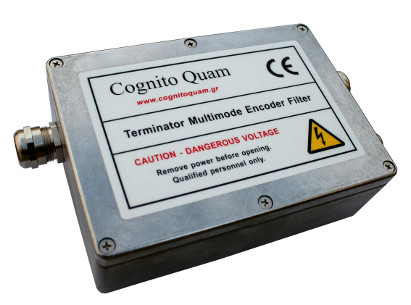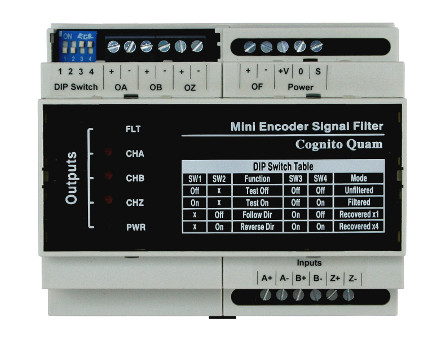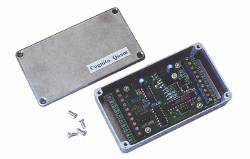

| Multimode Encoder Signal Filters Overview |
| Site Map | Home | All Products | Test & Measurement | Robotics & Motion Control |

Terminator multimode encoder signal filter |

Mini multimode encoder signal filter |
The filters remove all types of electrical noise (common and differential mode, dV/dt transients, ground loop generated etc.) in the encoder signal lines as well as the corrupting effects of mechanical noise and vibration (phantom movement, dither etc.). They reconstruct the encoder signals to reflect the correct encoder position and speed signaling. Performance is safeguarded and problems such as:
In addition to the above, our specialty multimode frequency averaging filters process the encoder signals to reproduce them at average input frequency in speed/velocity control applications.
Our multimode filters are offered in two standard lines: the fully featured Terminator line and the low cost Mini line which addresses less demanding applications. Both are all-in-one, comprehensive products, each device addressing all and any combination of known encoder application issues. Both types process digital quadrature encoder signals with the following features and characteristics:
| Multimode Encoder Filter Model Line-up and Features Overview | ||
| Feature |  Terminator line |
 Mini line |
| Galvanically isolated input and output stages to interrupt unavoidable system ground loops eliminating related noise as well as protecting the input stage of the driven controller from high voltage transients. | 5 V/ns minimum dV/dt galvanic barrier immunity | 0.1 V/ns minimum dV/dt galvanic barrier immunity |
Four selectable modes of digital processing:
|
Yes | Yes |
| Test mode. Depending on the chosen mode the filter outputs simulate the function of a 1024 ppr encoder | Output frequency is 1/64 the chosen sampling frequency | Output frequency is fixed |
| Direction reversal. One of the encoder channels can be complemented to effect a direction reversal, thus saving the rewiring/reconnection of the encoder signals. | Yes | Yes |
| Supply, signal and worn/faulty encoder indication. Five LEDs indicate the status of the power supply, the three encoder channels and the presence of out-of-sequence signalling, typically caused by a worn or faulty encoder. | Yes | Yes |
| DIP switch selectable options. All operational parameters and functions are set/reset via DIP switches. | Yes | Yes |
| Selectable sampling frequency. The encoder signals are DSP processed at selectable frequencies to interface to slower equipment or tune out problem noise sources in particularly difficult applications. | Yes | No |
| Types of EIA(RS)422 input termination | Standard DC, AC and none | Standard DC and none |
| Power supply | Internal dual voltage 115/230 VAC twin isolated supply. The twin supply powers the two internally isolated, input and output, filter sections and can also power the monitored encoder with regulated 5 VDC or unregulated 10/15 VDC | None. Power must be supplied externally to each of the two filter sections. |
| Enclosure | Cast aluminum enclosure of IP65 protection and high noise immunity. | Plastic, DIN rail mountable, IP40 protected. |
| Available speed grades (table below) | High, Standard and Low | Basic only |
The above all-in-one, multimode approach is justified when considering that in practical applications there is typically more than one mechanism at play eroding encoder performance at any time (see our paper on this or the encoder filter FAQ page). This makes a multimode filter the only effective, efficient, viable and conclusive solution to encoder noise problems.
The filters are characterized by their speed grade specifying the maximum quadrature input frequency which can be processed. The limit is different for each filter mode:
| Maximum Quadrature Input Frequency Capability per Filtering Mode | ||||
| Speed Grade | Unfiltered | Filtered | Recovered x1 | Recovered x4 |
| Basic | 300 kHz | 125 kHz | 100 kHz | 31.3 kHz |
| Low | 300 kHz | 250 kHz | 200 kHz | 62.5 kHz |
| Standard | 10 MHz | 1.5 MHz | 1.2 MHz | 375 kHz |
| High | 10 MHz | 3.0 MHz | 2.4 MHz | 1.5 MHz |
The filter design is characterized by typical industrial application considerations: low ownership cost, standard interfacing, fool-proof installation, transparent operation, results-oriented and all-inclusive design. The filters feature the following operational characteristics:
| You can buy small quantities of the Terminator and Mini filters online here. |
 in custom versions for OEMs. |
| Back to top | Site Map | Test & Measurement | Robotics & Motion Control | All Products |